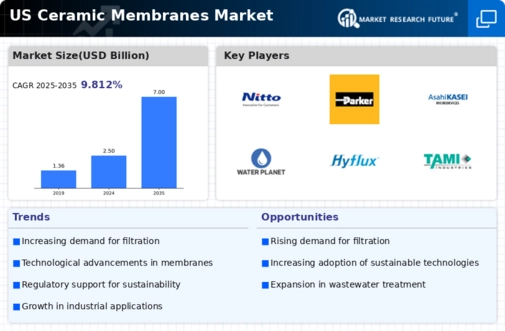Rising Environmental Regulations
The ceramic membranes market is being propelled by stringent environmental regulations aimed at reducing pollution and promoting sustainable practices. Regulatory bodies in the United States are increasingly mandating the use of advanced filtration technologies in various sectors, including wastewater treatment and industrial processes. Compliance with these regulations often necessitates the adoption of ceramic membranes, which are known for their efficiency and durability. As industries strive to meet these regulatory requirements, the demand for ceramic membranes is expected to increase, thereby enhancing the growth prospects of the ceramic membranes market. This regulatory landscape is likely to create a favorable environment for market expansion.
Focus on Water Reuse and Recycling
The growing emphasis on water reuse and recycling in the United States is significantly influencing the ceramic membranes market. With increasing water scarcity and the need for sustainable water management practices, industries are turning to advanced filtration technologies. Ceramic membranes offer high rejection rates for contaminants, making them ideal for treating wastewater and reclaiming water for industrial use. The market for water treatment is expected to grow at a CAGR of around 8% through 2027, with ceramic membranes playing a crucial role in this transformation. This trend indicates a robust future for the ceramic membranes market as it aligns with environmental sustainability goals.
Increasing Industrial Applications
The ceramic membranes market is experiencing growth due to the increasing adoption of ceramic membranes in various industrial applications. Industries such as food and beverage, pharmaceuticals, and petrochemicals are increasingly utilizing ceramic membranes for their superior filtration capabilities. The market is projected to reach approximately $1.5 billion by 2026, driven by the need for efficient separation processes. The ability of ceramic membranes to withstand harsh conditions and their longevity compared to polymeric membranes make them a preferred choice in these sectors. As industries seek to enhance productivity and reduce operational costs, the demand for ceramic membranes is likely to rise, thereby positively impacting the ceramic membranes market.
Growing Demand for High-Performance Filtration
The increasing demand for high-performance filtration solutions is a key driver for the ceramic membranes market. Industries are seeking advanced filtration technologies that can provide superior separation efficiency and reliability. Ceramic membranes are recognized for their ability to operate under extreme conditions, making them suitable for challenging applications such as oil and gas, pharmaceuticals, and food processing. The market is projected to grow as more companies recognize the long-term cost benefits and operational efficiencies associated with ceramic membranes. This trend suggests a robust future for the ceramic membranes market, as it aligns with the evolving needs of various sectors.
Technological Innovations in Membrane Manufacturing
Technological advancements in membrane manufacturing are significantly impacting the ceramic membranes market. Innovations such as the development of new materials and improved fabrication techniques are enhancing the performance and cost-effectiveness of ceramic membranes. These advancements allow for the production of membranes with higher permeability and selectivity, catering to diverse applications. The market is witnessing a shift towards more efficient and sustainable manufacturing processes, which could potentially lower production costs and increase accessibility. As these technologies continue to evolve, they are likely to drive the growth of the ceramic membranes market, making it more competitive and attractive to various industries.

















Leave a Comment